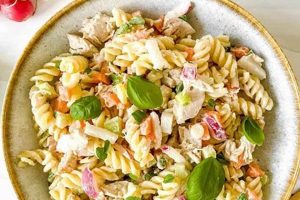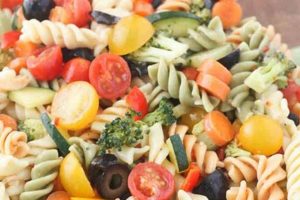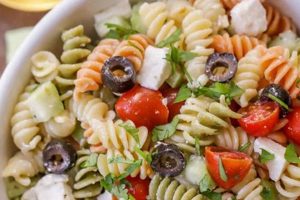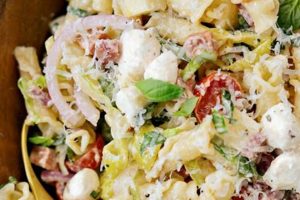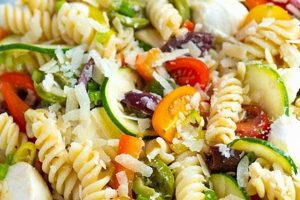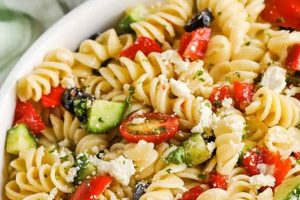This dish typically combines cooked orzo pasta, a small rice-shaped pasta, with a vibrant lemon dressing. Common additions include fresh herbs like dill or parsley, vegetables such as chopped cucumbers, tomatoes, or bell peppers, and sometimes feta cheese or other proteins like chickpeas or grilled chicken. Variations exist, offering flexibility in ingredients and flavors to suit individual preferences.
A light and refreshing dish, it is well-suited for warm weather or as a side dish to grilled meats or fish. The lemon dressing provides a bright, tangy flavor, while the orzo offers a satisfying texture. Its adaptability makes it suitable for picnics, potlucks, and casual meals, offering a simple yet flavorful culinary experience. Historically, pasta salads gained popularity as refrigeration became more widespread, allowing for safe preparation and storage of cold dishes. Lemon’s historical use as a flavoring agent in Mediterranean cuisine likely influenced its incorporation into this type of pasta salad.
Further exploration could delve into specific recipe variations, nutritional information, tips for preparation and storage, and suggestions for complementary dishes. A detailed examination of the individual components, such as different types of orzo or variations in lemon dressings, could also enhance understanding and appreciation of this versatile culinary creation.
Tips for Preparing a Delicious Lemon Orzo Pasta Salad
Achieving optimal flavor and texture requires attention to several key aspects of preparation.
Tip 1: Cook the Orzo Properly: Orzo should be cooked al dente, meaning firm to the bite. Overcooked orzo will result in a mushy texture in the salad. Follow package directions for cooking time, typically 8-10 minutes.
Tip 2: Rinse the Orzo: After cooking, rinse the orzo under cold water to stop the cooking process and cool it down quickly. This helps maintain its texture and prevents it from sticking together.
Tip 3: Use Freshly Squeezed Lemon Juice: Bottled lemon juice often contains preservatives and lacks the bright, fresh flavor of freshly squeezed lemons. For the best flavor, use freshly squeezed lemon juice in the dressing.
Tip 4: Balance the Dressing: A well-balanced dressing is crucial. Combine lemon juice, olive oil, salt, and pepper, adjusting the proportions to taste. A touch of sweetness, such as a small amount of honey or sugar, can enhance the flavor profile.
Tip 5: Incorporate Fresh Herbs: Fresh herbs add brightness and depth of flavor. Dill, parsley, mint, and oregano are excellent choices. Add the herbs just before serving to maintain their vibrant flavor and appearance.
Tip 6: Choose Complementary Vegetables: Select vegetables that complement the lemon flavor, such as cucumbers, tomatoes, bell peppers, red onion, or Kalamata olives. Consider roasted vegetables for a deeper, more complex flavor.
Tip 7: Enhance with Optional Ingredients: Feta cheese, crumbled goat cheese, or chickpeas can add protein and textural contrast. Grilled chicken or shrimp can also be incorporated for a more substantial meal.
Tip 8: Chill Before Serving: Allowing the salad to chill in the refrigerator for at least 30 minutes before serving allows the flavors to meld and enhances the refreshing quality of the dish.
By following these tips, one can create a flavorful and well-balanced dish that highlights the bright, zesty flavors of lemon and the satisfying texture of orzo.
This section’s guidance provides a solid foundation for creating a successful dish. The following conclusion will summarize the key benefits and offer final recommendations.
1. Orzo Pasta
Orzo pasta serves as the foundational ingredient in a lemon orzo pasta salad recipe. Its unique characteristics significantly influence the dish’s overall texture, flavor absorption, and aesthetic appeal. Understanding these attributes provides a deeper appreciation for orzo’s role in this culinary creation.
- Shape and Size:
Orzo’s small, rice-like shape distinguishes it from other pasta varieties. This characteristic allows it to absorb the lemon dressing effectively, ensuring a flavorful and cohesive salad. Its size also contributes to a pleasant mouthfeel, distinct from longer pasta shapes. In a lemon orzo pasta salad, this translates to a balanced distribution of flavor throughout the dish.
- Cooking Properties:
Orzo cooks relatively quickly, typically requiring 8-10 minutes. Achieving an “al dente” texture, firm to the bite, is crucial for preventing a mushy salad. Rinsing the cooked orzo under cold water halts the cooking process and maintains its desirable firmness. Proper cooking ensures a light and refreshing salad, enhancing the interplay of flavors.
- Flavor Absorption:
Orzo’s porous surface readily absorbs the bright, citrusy flavors of the lemon dressing. This absorption creates a harmonious blend of tastes, where the lemon’s tang complements the mild flavor of the pasta. The ability of orzo to absorb flavors makes it an ideal base for vibrant, flavorful salads.
- Versatility:
While crucial to the lemon orzo pasta salad, orzo’s versatility extends to other culinary applications. It can be incorporated into soups, pilafs, and other salads, showcasing its adaptability. This inherent versatility allows for creative variations and experimentation within different culinary contexts.
The specific attributes of orzo pasta its shape, cooking properties, flavor absorption, and versatility contribute significantly to the success of a lemon orzo pasta salad recipe. These characteristics ensure a balanced, flavorful, and texturally pleasing dish that exemplifies the harmonious combination of ingredients.
2. Fresh Lemons
Fresh lemons constitute a cornerstone of a successful lemon orzo pasta salad recipe, providing the signature citrusy brightness that defines the dish. Their contribution extends beyond mere flavoring, influencing the overall sensory experience and offering nutritional benefits.
- Flavor Profile:
Freshly squeezed lemon juice possesses a distinctive tangy and acidic flavor profile absent in bottled alternatives. This vibrancy enlivens the orzo pasta and other ingredients, creating a refreshing and balanced taste. The natural acidity also complements the richness of olive oil and enhances the flavors of added vegetables and herbs. This bright, acidic note distinguishes the dish, making it particularly appealing in warmer weather.
- Aromatic Complexity:
The aroma of fresh lemons contributes significantly to the sensory appeal of the dish. The zest, containing essential oils, adds a fragrant layer of citrus, intensifying the overall sensory experience. This aromatic complexity complements the other ingredients, creating a more nuanced and appealing dish. The combination of zest and juice provides a depth of flavor unmatched by processed lemon juice.
- Nutritional Value:
Fresh lemons offer nutritional value beyond their flavor contribution. They are a source of Vitamin C, an antioxidant that supports immune function. Furthermore, the citric acid in lemon juice can aid in digestion. Incorporating fresh lemons enhances not only the flavor but also the nutritional profile of the pasta salad.
- Balancing Agent:
The acidity of fresh lemons acts as a balancing agent within the recipe. It cuts through the richness of the olive oil and other ingredients, preventing the dish from becoming overly heavy. This balance ensures a refreshing and palatable salad. The acidity also helps preserve the vibrant colors of the vegetables, maintaining an appealing visual presentation.
The use of fresh lemons elevates the lemon orzo pasta salad from a simple combination of ingredients to a vibrant, flavorful, and nutritionally beneficial dish. The interplay of flavor, aroma, nutritional value, and balancing acidity underscores the essential role fresh lemons play in creating a truly exceptional culinary experience.
3. Vivid Herbs
Vivid herbs play a crucial role in elevating the lemon orzo pasta salad recipe beyond a simple combination of ingredients. Their aromatic and flavor contributions transform the dish, adding depth, complexity, and a refreshing element that complements the lemon and other components. An exploration of specific herbs reveals their individual contributions and synergistic effects within the recipe.
- Fresh Dill:
Dill’s slightly tangy, anise-like flavor harmonizes exceptionally well with lemon. Its feathery fronds offer a delicate texture and visual appeal. Dill’s distinct aroma enhances the overall sensory experience, making it a classic pairing for lemon-based dishes, particularly in Mediterranean cuisine.
- Flat-Leaf Parsley:
Parsley provides a fresh, slightly peppery flavor that balances the lemon’s acidity. Its bright green color adds vibrancy to the salad’s presentation. Parsley’s versatility makes it a reliable choice, complementing a wide range of ingredients without overpowering other flavors.
- Fresh Mint:
Mint introduces a cooling element to the pasta salad, offering a refreshing contrast to the lemon’s tang. Its distinctive aroma adds another layer of complexity. While mint can be a strong flavor, using it judiciously provides a pleasant herbal note that enhances the overall sensory experience.
- Oregano:
Oregano contributes a slightly earthy, pungent flavor that complements the lemon and other Mediterranean-inspired ingredients. Its robust flavor adds depth and complexity, particularly when combined with ingredients like feta cheese and olives. Oregano’s presence enhances the overall savory profile of the dish.
The careful selection and combination of these vivid herbs significantly enhance the lemon orzo pasta salad recipe. Their individual flavors and aromas create a synergistic effect, transforming a basic pasta salad into a multi-dimensional culinary experience. The interplay of these herbal notes elevates the brightness of the lemon, creating a harmonious and refreshing dish.
4. Crisp Vegetables
Crisp vegetables contribute significantly to the texture, flavor, and nutritional value of a lemon orzo pasta salad. Their presence offers a refreshing counterpoint to the orzo pasta and the bright lemon dressing. The selection and preparation of these vegetables directly influence the overall quality and sensory experience of the dish.
Textural contrast is a primary benefit of incorporating crisp vegetables. Cucumbers, bell peppers, and red onion, when appropriately chopped and added raw, provide a satisfying crunch. This contrasts with the soft texture of the cooked orzo, creating a more dynamic and enjoyable mouthfeel. Blanched or lightly steamed vegetables, such as broccoli or green beans, can also be incorporated, offering a slightly softer yet still distinct textural element. The interplay of textures enhances the overall sensory experience, making the salad more appealing.
Beyond texture, crisp vegetables introduce additional flavor dimensions. The subtle sweetness of bell peppers, the mild bite of red onion, and the refreshing coolness of cucumbers complement the lemon dressing’s tangy brightness. These flavors harmonize without overpowering the core lemon profile, creating a well-balanced and nuanced taste. Furthermore, the visual appeal of colorful vegetables enhances the presentation, making the salad more inviting. The variety of colors and shapes adds to the aesthetic appeal, stimulating visual interest alongside the taste experience.
Nutritional value is another key consideration. Crisp vegetables are often rich in vitamins, minerals, and fiber. Adding these elements to the lemon orzo pasta salad increases its nutritional density, offering a more wholesome and balanced meal. This nutritional boost complements the other ingredients, creating a dish that satisfies both palate and dietary needs. The inclusion of crisp vegetables allows for a lighter, more nutrient-rich dish compared to heavier pasta salads.
5. Flavorful Additions (Optional)
Flavorful additions, while optional, offer opportunities to elevate the lemon orzo pasta salad recipe, introducing complexity and textural variety. These additions can transform the dish from a simple side to a more substantial and satisfying meal. Careful consideration of these components ensures they complement the existing flavors without overpowering the core profile of lemon and orzo.
- Cheese:
Cheese introduces a salty, creamy element that contrasts with the bright lemon and fresh vegetables. Feta cheese, with its briny and slightly tangy flavor, is a classic pairing with Mediterranean-inspired dishes. Crumbled goat cheese offers a sharper, more assertive flavor, while Parmesan provides a nutty, savory depth. The choice of cheese influences the overall flavor profile and richness of the salad.
- Protein:
Adding protein transforms the salad into a complete meal. Grilled chicken or shrimp provide lean protein options that complement the light and refreshing nature of the salad. Chickpeas offer a vegetarian alternative, adding a nutty flavor and substantial texture. The inclusion of protein enhances the salad’s satiety and nutritional value.
- Nuts and Seeds:
Toasted pine nuts, slivered almonds, or sunflower seeds introduce a satisfying crunch and nutty flavor dimension. These additions also contribute healthy fats and enhance the overall textural complexity of the dish. Their presence elevates the salad beyond a simple combination of ingredients, adding a gourmet touch.
- Olives:
Olives, particularly Kalamata olives, offer a briny, salty, and slightly bitter counterpoint to the lemon’s brightness. They provide a burst of flavor and a satisfying chewiness, enhancing the overall sensory experience. The choice of olive variety can significantly influence the final flavor profile of the salad.
These optional additions, when thoughtfully incorporated, elevate the lemon orzo pasta salad recipe. The interplay of flavors and textures transforms the dish into a more complex and satisfying culinary creation. Careful consideration of these elements ensures a balanced and harmonious flavor profile that complements the core ingredients while offering customization based on individual preferences.
6. Balanced Dressing
A balanced dressing is paramount to a successful lemon orzo pasta salad recipe. The dressing acts as the unifying element, binding the individual components and influencing the overall flavor profile. A well-balanced dressing enhances, rather than masks, the flavors of the orzo, vegetables, herbs, and any additional ingredients. It achieves this through a harmonious blend of acidity, richness, and seasoning.
Acidity, primarily derived from lemon juice, provides the signature brightness characteristic of this dish. However, excessive acidity can be overpowering. The sharpness of the lemon juice needs to be tempered with richness, typically from olive oil. The oil contributes a smooth mouthfeel and a subtle fruity flavor that complements the lemon. The ratio of lemon juice to olive oil is crucial; too much oil can result in a greasy salad, while too much lemon juice creates an excessively tart taste. A typical starting point is a 3:1 ratio of oil to lemon juice, but adjustments can be made based on personal preference and the specific ingredients used. For example, if the salad incorporates salty elements like feta cheese or olives, slightly less lemon juice might be desirable.
Seasoning completes the balance. Salt and freshly ground black pepper enhance the other flavors without being dominant. A touch of sweetness, often from a small amount of honey or sugar, can further round out the dressing, balancing the acidity and adding depth. Herbs and spices, incorporated directly into the dressing or added separately to the salad, contribute additional flavor nuances. Achieving this delicate balance ensures that the dressing complements, rather than overpowers, the other components, resulting in a harmonious and flavorful final dish. Failure to achieve this balance can result in a salad that is either too tart, too bland, or too oily, diminishing the overall enjoyment of the dish.
7. Proper Cooking Technique
Proper cooking technique is essential for a successful lemon orzo pasta salad recipe. The texture of the orzo pasta significantly influences the final dish’s overall quality. Overcooked orzo results in a mushy, unappetizing salad, while undercooked orzo presents a hard, unpleasant texture. Achieving the ideal “al dente” texture, where the pasta is cooked through but still firm to the bite, is crucial for both taste and mouthfeel. A thorough understanding of cooking times and rinsing techniques contributes directly to a delightful culinary experience.
- Orzo Cooking Time:
Orzo, being a small pasta shape, cooks relatively quickly. Adhering to package directions is crucial, but generally, orzo cooks in approximately 8-10 minutes. Monitoring the cooking process and testing the orzo for doneness ensures optimal results. Overcooking, even by a minute or two, can drastically alter the texture, leading to a less desirable salad. Factors such as altitude and variations in stovetop heat may require slight adjustments to cooking times.
- The “Al Dente” Texture:
“Al dente,” meaning “to the tooth” in Italian, describes pasta cooked to a firm yet tender consistency. For orzo pasta salad, this texture is ideal. It provides a pleasant chewiness without being hard or mushy. Achieving this texture requires careful attention during the cooking process and frequent testing of the pasta as it approaches the recommended cooking time.
- Rinsing the Orzo:
Rinsing cooked orzo under cold water serves two crucial purposes. First, it immediately stops the cooking process, preventing the orzo from becoming overcooked due to residual heat. Second, the cold water cools the orzo quickly, which helps maintain its firm texture and prevents the individual pieces from sticking together. This step is particularly important for pasta salads, as it ensures a light and refreshing final dish.
- Draining and Drying:
Thoroughly draining the rinsed orzo removes excess water, which can dilute the dressing and make the salad watery. After draining, spreading the orzo out on a baking sheet or large plate to air dry further helps prevent sticking and ensures a light, fluffy texture. This step is often overlooked but contributes significantly to the salad’s final quality.
Mastering these proper cooking techniques ensures that the orzo pasta contributes optimally to the lemon orzo pasta salad. The resulting texture enhances the interplay of flavors with the lemon dressing, vegetables, and other ingredients, creating a harmonious and satisfying culinary experience. Attention to these details elevates the dish from simple to exceptional, showcasing the impact of proper cooking technique on the final product.
Frequently Asked Questions
This section addresses common inquiries regarding lemon orzo pasta salad recipes, providing concise and informative responses to facilitate successful preparation and enjoyment.
Question 1: Can alternative grains be substituted for orzo pasta?
While orzo provides a specific texture and flavor profile, other small pasta shapes like ditalini or couscous can be substituted. However, this may subtly alter the final dish’s characteristics.
Question 2: What is the best method for preventing the salad from becoming overly dry?
Adequate dressing and proper orzo cooking prevent dryness. Adding a small amount of reserved pasta water can also help maintain moisture.
Question 3: How long can the prepared salad be stored in the refrigerator?
Properly stored in an airtight container, lemon orzo pasta salad typically remains fresh for up to three days in the refrigerator.
Question 4: Can the lemon dressing be made in advance?
The lemon dressing can be prepared in advance and stored separately. However, adding the dressing to the salad just before serving maintains optimal flavor and texture.
Question 5: What protein sources best complement this salad?
Grilled chicken, shrimp, or chickpeas complement the flavors well. These additions enhance nutritional value and create a more substantial meal.
Question 6: How can one adjust the recipe for dietary restrictions, such as gluten-free or vegan diets?
Gluten-free orzo is available for those with gluten sensitivities. For vegan variations, ensure all added ingredients, including cheese, align with dietary restrictions. Nutritional yeast can provide a cheesy flavor alternative.
Understanding these common inquiries contributes to successful preparation and enjoyment of lemon orzo pasta salad. Careful consideration of these points ensures a satisfying culinary experience tailored to individual preferences and dietary needs.
The subsequent section provides a concluding overview and final recommendations for creating a delicious and memorable lemon orzo pasta salad.
Conclusion
Exploration of the lemon orzo pasta salad recipe reveals a dish offering versatility and a refreshing flavor profile. Emphasis on fresh ingredients, proper cooking techniques, and a balanced dressing contributes significantly to the final product’s success. From the foundational orzo pasta to the nuanced inclusion of herbs and optional additions, each component plays a crucial role in the overall culinary experience. Proper attention to detail, from cooking times to ingredient selection, elevates this dish beyond a simple pasta salad.
This exploration serves as a foundation for culinary experimentation and adaptation. Potential exists for personalized variations, incorporating diverse ingredients and flavor profiles while maintaining the core principles of balance and freshness. The lemon orzo pasta salad, a testament to culinary simplicity and adaptability, invites exploration and enjoyment, promising a delightful gastronomic experience adaptable to a range of occasions and palates.

